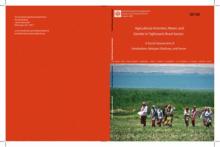Land Library Search
Through our robust search engine, you can search for any item of the over 73,000 highly curated resources in the Land Library.
If you would like to find an overview of what is possible, feel free to peruse the Search Guide.
/ library resources
Showing items 1 through 9 of 11.The report is an initiative of the Agriculture and Rural Development Department (ARD) of the World Bank. Aquaculture is the fastest-growing food sector in the world and is expected to contribute more than 50 percent of total fish consumption by 2020.
Three out of every four poor people in developing countries live in rural areas, and most of them depend directly or indirectly on agriculture for their livelihoods. In many parts of the world, women are the main farmers or producers, but their roles remain largely unrecognized.
This social assessment (SA) was conducted under the Fergana Valley Water Resources Management Project (FVWRMP), which is providing assistance to the Government of Tajikistan to address irrigation and drainage deficiencies in Eastern Sughd.
Climate change presents a profound challenge to food security and development.
The Country Environmental Analysis (CEA) for Timor-Leste identifies environmental priorities through a systematic review of environmental issues in natural resources management and environmental health in the context of the country's economic development and environmental institutions.
South Africa has rapidly reduced trade barriers since the end of Apartheid, yet agricultural production and exports have remained sluggish. Also, poverty and unemployment have risen and become increasingly concentrated in rural areas.
Using recent estimates of industry assistance rates, the effects of trade liberalization in the rest of the world and in Pakistan alone are analyzed using a global and a Pakistan computable general equilibrium (CGE) model under two tax replacement schemes: a direct income tax and an indirect tax
This paper analyzes the political and institutional factors which are behind the dramatic changes in distortions to agricultural incentives in the transition countries in East Asia, Central Asia, and the rest of the former Soviet Union, and in Central and Eastern Europe.
Although economic reform has brought remarkable progress in poverty reduction in Vietnam, the scale and depth of ethnic minority poverty in Vietnam presents one of the major challenges to achieving the targets for poverty reduction set out in the Socio-Economic Development Plan, as well as the mi









